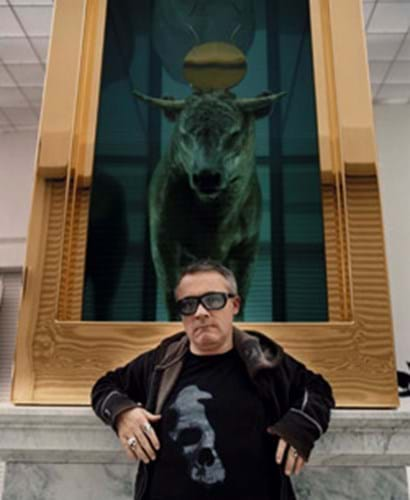
Like anything that can be traded, art is only worth what someone is prepared to pay, and enough people were prepared bid up the animal tanks, butterfly canvases, spin pictures and spot paintings for Hirst surely now to feel bountiful inside his wallet forever.
The 56-lot evening sale on September 15 saw a £61.2m hammer total against a pre-sale estimate of £43.2m-62.3m. Only two lots were unsold, and they went immediately after the sale.
This was followed by a further £34.4m from the day sale with only three unsolds.
There was cheering and whooping from Sotheby's staff at the press conference - perhaps a reflection of just how much was riding on this auction.
The pre-sale omens were not ideal. A story emerged that 200 works by Hirst remained unsold in the stockroom of his London dealers White Cube, while some jitters had been seen in the Hirst market at this summer's round of contemporary art auctions. Hirst himself had steadied the ship with the announcement his workshop would cease production of spin and butterfly paintings.
The evening sale also came on the blackest day on Wall Street since 9/11. The collapse of investment bank Lehman Brothers and the announcement of a rescue package by the Bank of America for the take-over of Merrill Lynch added to the sense that this could be the moment when the contemporary art bubble finally bursts.
According to reports, some traders were betting on just that by taking 'short' positions on a predicted fall in Sotheby's share price.
But the first lot set the pace for the sale. Heaven Can Wait, a large triptych with butterflies estimated at £300,000-500,000, took £850,000.
It was bought by White Cube's Jay Jopling, vigorously chewing gum as proceedings got underway. Perhaps he had more to lose than anyone.
A spokesman from White Cube told The Times that they had bid on 20 of the lots at the evening sale. There was also bidding from Hirst's New York dealer Gagosian and New York dealer Alberto Mugrabi who bought two works.
The most prolific buyer at the evening sale, however, was a European private collector bidding on the telephone manned by Sotheby's Alina Davey, a Russian-speaker who works for Sotheby's private client group in London. This buyer purchased eight works including the most strongly contested lot, Fragments of Paradise, a 9ft-wide stainless-steel cabinet containing thousands of manufactured diamonds. It sold well beyond its £1m-1.5m estimate for £4.6m.
Sotheby's, who had undertaken their "most novel and comprehensive marketing campaign", reported an unprecedented number of new buyers across a broad geographical range. There were 750 registered bidders over the two sales.
Eighteen per cent of the buyers at the evening sale were new to Sotheby's, with a quarter coming from the emerging markets. Furthermore, 35 per cent of the buyers were new to Sotheby's contemporary art department.
The top lot was The Golden Calf, a Charolais bull in formaldehyde on a Carrara marble plinth with hooves and horns plated in 18 carat gold. With interest in the room and three telephones, it was knocked down to a telephone at £9.2m, a new auction record for the artist.
When asked after the evening sale how the auction prices compared to what would have been charged in a gallery, Sotheby's senior international specialist Oliver Barker said they were greater. However, this is difficult to judge as the galleries who deal with Hirst do not make their prices public.
The speculation before the sale was that the estimates were pitched around 20 per cent lower than gallery price levels in the hope of encouraging bidding. Ultimately three-quarters of the lots went over their top estimate when premium was added.
One claim that was less justified was that Hirst had made great savings, consigning new works directly to auction. Hirst and his canny business manager Frank Dunphy are thought to have negotiated deals with their galleries where they receive between 80 and 90 per cent of the sales. This return would be largely equivalent to the premium charged by Sotheby's, where a work that sells for £1m attracts a premium of just over 16 per cent.
Either way, the success of this sale will provide a useful bargaining tool for the Hirst camp in future negotiations with galleries.
Despite the huge media attention, Damien Hirst himself was apparently nervous before the sale and spent the evening playing snooker. But the world's most talked-about artist said afterwards: "I think the market is bigger than anyone knows. I love art and this proves I'm not alone and the future looks great for everyone."
But outside Sotheby's that evening was the lone voice of a single protester saying she was campaigning for "real artists".
By Alex Capon
For further facts from the Damien Hirst sale, click here.
For dealers' reaction to the Damien Hirst sale, click here.




